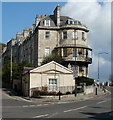1
Morford Street, Bath, 1966
It took me some time to identify this street (which was mis-named in my index) because much of it has been demolished and replaced by modern buildings https://goo.gl/maps/pVCcogJ7wSHA69zZ9 . The remaining old buildings on the left hand side were built between 1775 and 1789 and are individually Listed Grade II.
Image: © Alan Murray-Rust
Taken: 18 Jul 1966
0.03 miles
2
Bath; Lansdown Hill etc. from Prior Park
Beckford's Tower top left, St. Stephen's Church near top right, with Camden Crescent below, and The Paragon below that. Lansdown Grove Hotel almost in the centre. St Michael's Church spire seen above trees at bottom, with The Tramshed's long glass skylights seen to the right of those trees.
Image: © Roger Beale
Taken: 16 Aug 2010
0.04 miles
3
Benchmark on the pub
Handily placed for the thirsty traveller, this cut mark is on The Old Farmhouse. See http://www.bench-marks.org.uk/bm37543 for the Benchmark Database.
Image: © Neil Owen
Taken: 8 Apr 2011
0.04 miles
4
Ye Olde Farmhouse
Pub on Lansdown Road, Bath.
Image: © Wayland Smith
Taken: 10 Nov 2012
0.04 miles
5
Ye Old Farmhouse, Bath
Pub at 1 Lansdown Road on the corner of Camden Row.
The years 1600 and 1892 are inscribed on the corner wall of the building.
Image: © Jaggery
Taken: 24 Sep 2011
0.04 miles
6
The Flying Pig Renovation Company, Bath
Office at 27 Belvedere. The company specialises in renovating
and refurbishing property in the city of Bath.
Image: © Jaggery
Taken: 24 Sep 2011
0.04 miles
7
Keep in low gear down Belvedere, Bath
The sign on the left shows an 11% (1 in 9) descent ahead.
Image: © Jaggery
Taken: 24 Sep 2011
0.04 miles
8
Christ Church, Julian Rd, Bath
This church was consecrated in 1798. It is unusual in being a Church of England proprietary chapel, not a parish church, now one of only a handful of such places of worship remaining.
From the church website http://www.christchurchbath.org/ :
"Christ Church was founded at the end of the 18th century in the fashionable, prosperous city of Bath, a city very attractive to the wealthy visitors who took the waters and engaged in a variety of pleasurable activities. The city’s churches prospered by charging pew rents, which meant, however, that the poorer people could not afford to attend church. To remedy this, a group of socially inclined men opened a voluntary subscription fund to build a new church in which the ground floor should provide seating free of charge for any who wished to attend services, while the gallery seats would be let at a price sufficient to pay clergy and other staff. Early supporters included the Archbishop of Canterbury, the great evangelical and campaigner against slavery William Wilberforce, and Martin Stafford Smith, godfather of John Keble, a founder of the Oxford Movement.
When it was completed in 1798, Christ Church was a typical late 18th century 'preaching house', with a gallery, a central pulpit and a small free-standing altar. About 70 years later, after the influence of the Oxford Movement and in a typical act of Victorian exuberance, the house next to the east end of the church was bought and demolished to make way for a large apse, in a much more Catholic style. Christ Church today is defined as a proprietary chapel, sometimes known with slight amusement as a 'Peculiar in Ordinary', owned by a charitable Trust. It lies geographically within the Parish of St Swithin’s, Walcot, but has no organisational link to that church beyond St Swithin’s having a representative on the Trustees."
Image: © HelenK
Taken: 4 Feb 2010
0.05 miles
9
Benchmark by the railings
Despite being partly shielded by railings, the cut mark has suffered damage and weathering. See http://www.bench-marks.org.uk/bm37542 for the Benchmark Database.
Image: © Neil Owen
Taken: 8 Apr 2011
0.05 miles
10
Corner of Camden Row and Camden Crescent, Bath
Camden Row is on the left.
Image: © Jaggery
Taken: 24 Sep 2011
0.05 miles











